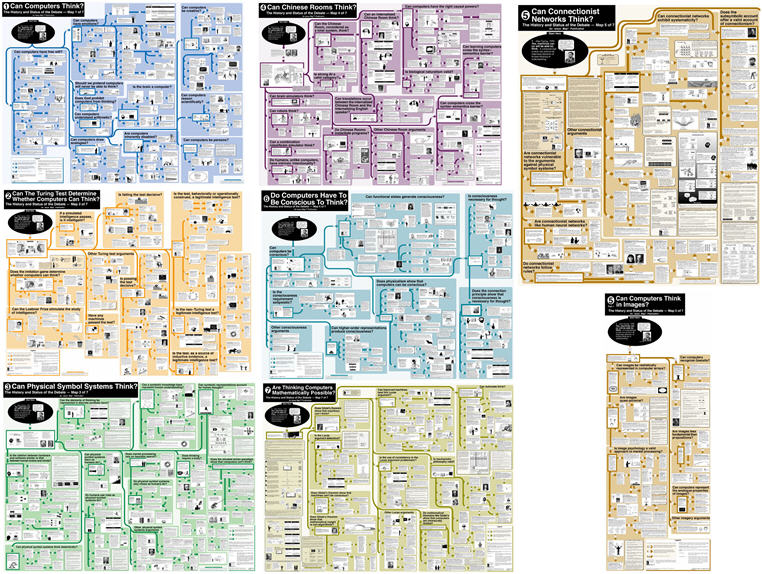We stand on the shoulders of giants…
“…so that we can see more than they, and things at a greater distance, not by virtue of any sharpness of sight on our part, or any physical distinction, but because we are carried high and raised up by their giant size.”
Robert Horn is one of my giants.
Twenty years ago, Bob looked at humanity’s troubled progress through the increasingly complex maze of philosophical, scientific, technological and political debate and realised that we needed maps.
But what kind of maps? What would they look like? What form would they take?
The way to figure this out, Bob reasoned, was to experiment with an extraordinarily complex debate. And he picked a spectacular one: the debate raging across philosophy, cognitive science, mathematics, neurobiology and computer science around the deceptively simple question “can computers think?”. A debate Alan Turing catalysed with his assertion in 1950 that by 2000:
“one will be able to speak of machines thinking without expecting to be contradicted.”
As with Orwell’s 1984, Turing’s date lies behind us now, but the issue has never been more salient for society.
Starting alone, and then with a team of researchers at Stanford, Bob devoured the relevant literature; distilling millions of words into the underlying arguments and iterating through multiple methods of presentation to develop a semantically rich and easy to navigate visual form.
The project culminated, in 1999, with the publication of seven remarkable 3’ x 4’ paper-based maps, encompassing more than 800 arguments advanced by over 300 of the finest minds of our generation, including: Alan Turing, John Searle, John Lucas, Herbert Simon, Douglas Hofstadter, Marvin Minsky, Daniel Dennett, Roger Penrose, Hilary Putnam, Stephen Kosslyn, Zenon Pylyshyn, James McClelland, Hubert Dreyfus, Ned Block, James Moor, Jack Copeland, Selmer Bringsjord, David Rumelhart, David Chalmers, and George Lakoff.
Robert Horn’s Can Computers Think? maps

(copies of the maps can be ordered here)
The set of maps is a masterpiece and an extraordinary gift to humanity; allowing anyone to gain a deep understanding of the structure and content of fifty years of intricate debate after a few hours of study rather than years of research. And it exemplifies the potential for maps of this kind to open other domains of debate and knowledge to general understanding.
At the time of publication, Robert Jacobson hailed Bob as “the new Mercator, a pioneering navigator of knowledge”—and, for anyone who has spent time with the set of maps, it easy to imagine that history will view its creation as a significant turning point in the advancement of human learning.
However, for all its astonishing brilliance, the set of maps also speaks to the challenges that remain in the field:
- The maps exist because of the Herculean endeavour of a small team of people over many years.
- The territory, unlike the maps, continues to evolve.
- The maps have physical boundaries, beyond which lie uncharted territory.
So what next?
What if you could lift Bob’s map off the page and recreate it online with all the arguments open to collaborative editing and evaluation by many people rather than a few; make the structure of the map fluid so that the debate can evolve as new arguments and evidence emerge; and allow related maps to interconnect so that, in principle, there is no limit to the territory that can be covered?
With Bob’s blessing, I am delighted to announce today that this is what we have done.
The top layer of the debate map is shown below: to open and explore the full map click on the View live button.
The translation will continue over the coming days, with more images and cross-relationships to add; however, the essence of the map is in place now and open to extension by anyone with an interest in the field.
If you would like to participate in this process, or the formal launch event next year, register online or contact me via the e-mail address above.
There’s more to discuss in future posts, including: the translation process, the expansion of the mapping approach to other fields, and the importance of the Can Computers Think? debate itself.
For now though, I’ll leave you with Bob’s map—and the view it affords from many tall shoulders.


